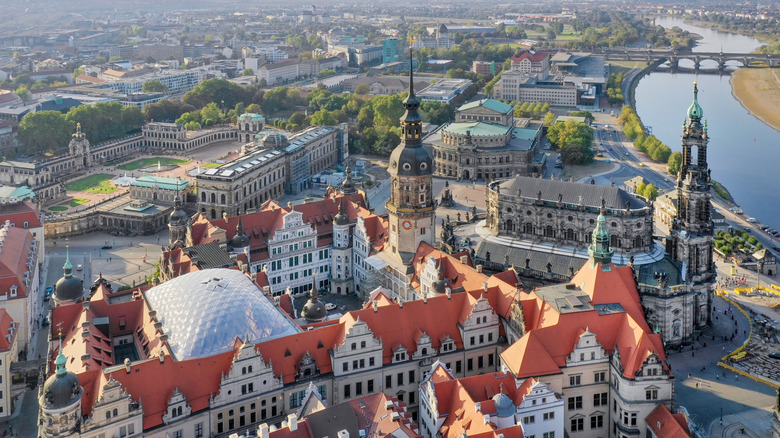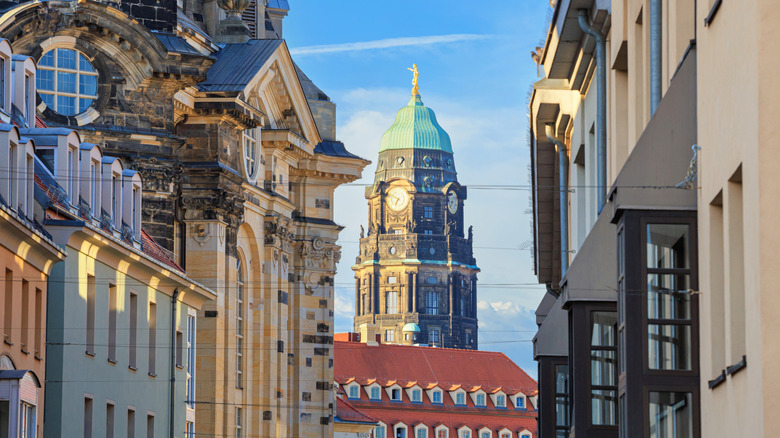Germany's Once-Thriving 'Jewel Box' Was Nearly Wiped Out But Is Now A Beloved, Wildly Popular Tourist City
The picturesque city of Dresden, Germany, is known for many things. Porcelain, Europe's oldest continuously-operating Christmas Market, palaces, and Baroque architecture galore. You'd never guess that the lovely boulevards of Dresden, along the banks of the River Elbe, were once reduced to rubble. This now-thriving metropolis was one of Germany's most destroyed cities after the devastating bombings of World War II. As you wander the cobbled streets around the Frauenkirche, it's hard to believe that these ancient, age-blackened stones that make up the intricate facade of this church haven't been standing for hundreds of years. It's hard to picture that these historic buildings were all rebuilt, painstakingly, thanks to the efforts of Dresden locals.
Before the war, Dresden, two hours south of Berlin and about an hour north of the Czech border, was known as the "Jewel Box" of Germany and the "Florence on the Elbe" thanks to its rich history, impressive art collections, and gorgeous architecture like the renowned Semper Opera House. Sadly, by the end of World War II, the city was virtually destroyed. Whatever was left fell into disuse when Dresden, under East Germany, was under Soviet rule. Locals said, "the Russians destroyed buildings more efficiently than any bombs," but once "the wall came down, we rebuilt our city brick by brick," (via National Geographic).
Although much of historical Dresden has been restored, the city doesn't feel stuck in the past. The stately streets of the Old Town thrum with humanity –– locals and tourists alike –– and the city stretching around it is a lively center of German industriousness and friendliness. There is power in preserving the past while embracing the future, and Dresden is a testament to this like no other.
How Dresden rebuilt after World War II
The final assault of bombs on Dresden by Allied Forces near the end of World War II seemed likely to spell the end of the city. The Neumarkt Dresden, the historic center of the city, was in rubble, and so were most of the city's beloved Baroque facades. After the end of the war, Dresden, now under Soviet control, continued to fall further into disrepair, mostly due to neglect. Some effort to rebuild was made in the 1970s, but after the reunification of Germany in the early 1990s, reconstruction was able to commence in earnest.
While some city planners advocated for reconstructing the city with modern design, local groups like the Gesellschaft Historischer Neumarkt Dresden and the Society for the Historical Neumarkt Dresden (GHND) campaigned to restore not just the old buildings, but the entire Neumarkt. One of the most successful campaigns was the "Ruf aus Dresden," or "call from Dresden," in which Dresdeners appealed to the world for the funds to reconstruct their beloved city symbol, the Frauenkirche, which was still a pile of scorched rubble in 1994. The church reopened in 2005, painstakingly restored stone by blackened stone, "like the world's most difficult jigsaw puzzle," a local Dresden tour guide told National Geographic. All of this effort has resulted in beautiful Dresden becoming one of the best destinations you can't skip on a trip to Germany.
What Dresden is like today
Today, these revitalized streets hold a variety of unmissable sights. At the Zwinger, a decadent palace built in the 1700s, visit some of Dresden's famous art at the Old Masters Picture Gallery, including a masterpiece from the Italian Renaissance: Raphael's "The Sistine Madonna." Also at the Zwinger, see the city's famous porcelain at the Dresden Porcelain Collection. For something more off-beat, visit the Mathematisch-Physikalischer Salon, where artifacts of science, like telescopes and globes, are on display.
Other highlights of Dresden include the famous Frauenkirche, a powerful symbol of reconciliation and a striking building in its own right, with an impressive stone dome. Another highlight is the Dresden Castle, especially its famous "Procession of Princes." This 335-foot-long mural, constructed with 24,000 porcelain tiles, tells the history of Saxony (the region of Dresden), which somehow survived the brutal bombings in 1945. For an extra challenge, find the sole woman in the entire mural! There's also the ornate Semperoper, the famous Opera House, and the Brühl Terrace along the Elbe, known as the "Balcony of Europe." In the evening, watch the sunset over the Elbe from a classic German beer garden.
There's more to Dresden than the gorgeous Old Town. Not far outside of the city is Meissen, home of the famous china, as well as Saxon-Switzerland National Park, one of Germany's prettiest national parks and an underrated gem with unique landscapes. The park is especially famous for its ornate stone bridge, the Bastei Bridge, which stretches for 250 feet (76.5 meters) between otherworldly rock formations, high above the valley. Also outside of Dresden is the sleepy Elbe Valley, a peaceful grassland where locals come to escape the city and enjoy the historic villas. And in the suburb of Radebeul, try some of Germany's delicious riesling.


